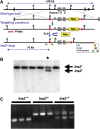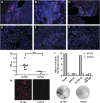Thymus-specific deletion of insulin induces autoimmune diabetes
- PMID: 19680229
- PMCID: PMC2750011
- DOI: 10.1038/emboj.2009.212
Thymus-specific deletion of insulin induces autoimmune diabetes
Abstract
Insulin expression in the thymus has been implicated in regulating the negative selection of autoreactive T cells and in mediating the central immune tolerance towards pancreatic beta-cells. To further explore the function of this ectopic insulin expression, we knocked out the mouse Ins2 gene specifically in the Aire-expressing medullary thymic epithelial cells (mTECs), without affecting its expression in the beta-cells. When further crossed to the Ins1 knockout background, both male and female pups (designated as ID-TEC mice for insulin-deleted mTEC) developed diabetes spontaneously around 3 weeks after birth. beta-cell-specific autoimmune destruction was observed, as well as islet-specific T cell infiltration. The presence of insulin-specific effector T cells was shown using ELISPOT assays and adoptive T cell transfer experiments. Results from thymus transplantation experiments proved further that depletion of Ins2 expression in mTECs was sufficient to break central tolerance and induce anti-insulin autoimmunity. Our observations may explain the rare cases of type 1 diabetes onset in very young children carrying diabetes-resistant HLA class II alleles. ID-TEC mice could serve as a new model for studying this pathology.
Conflict of interest statement
The authors declare that they have no conflict of interest.
Figures









Comment in
-
Insulin teaches a new lesson in tolerance.EMBO J. 2009 Sep 16;28(18):2687-8. doi: 10.1038/emboj.2009.251. EMBO J. 2009. PMID: 19759522 Free PMC article. No abstract available.
Similar articles
-
Insulin expression levels in the thymus modulate insulin-specific autoreactive T-cell tolerance: the mechanism by which the IDDM2 locus may predispose to diabetes.Diabetes. 2002 May;51(5):1383-90. doi: 10.2337/diabetes.51.5.1383. Diabetes. 2002. PMID: 11978634
-
Essential roles of insulin expression in Aire+ tolerogenic dendritic cells in maintaining peripheral self-tolerance of islet β-cells.Cell Immunol. 2012;273(2):115-23. doi: 10.1016/j.cellimm.2011.12.010. Epub 2012 Jan 12. Cell Immunol. 2012. PMID: 22297234
-
An HLA-Transgenic Mouse Model of Type 1 Diabetes That Incorporates the Reduced but Not Abolished Thymic Insulin Expression Seen in Patients.J Diabetes Res. 2016;2016:7959060. doi: 10.1155/2016/7959060. Epub 2015 Dec 28. J Diabetes Res. 2016. PMID: 26824049 Free PMC article.
-
Thymic B Cells as a New Player in the Type 1 Diabetes Response.Front Immunol. 2021 Oct 21;12:772017. doi: 10.3389/fimmu.2021.772017. eCollection 2021. Front Immunol. 2021. PMID: 34745148 Free PMC article. Review.
-
Thymic commitment of regulatory T cells is a pathway of TCR-dependent selection that isolates repertoires undergoing positive or negative selection.Curr Top Microbiol Immunol. 2005;293:43-71. doi: 10.1007/3-540-27702-1_3. Curr Top Microbiol Immunol. 2005. PMID: 15981475 Review.
Cited by
-
Insulin-secreting β cells require a post-genomic concept.World J Diabetes. 2016 May 25;7(10):198-208. doi: 10.4239/wjd.v7.i10.198. World J Diabetes. 2016. PMID: 27226815 Free PMC article. Review.
-
Inherent ER stress in pancreatic islet β cells causes self-recognition by autoreactive T cells in type 1 diabetes.J Autoimmun. 2016 Aug;72:33-46. doi: 10.1016/j.jaut.2016.04.009. Epub 2016 May 9. J Autoimmun. 2016. PMID: 27173406 Free PMC article.
-
RANKL-RANK interaction in immune regulatory systems.World J Orthop. 2012 Sep 18;3(9):142-50. doi: 10.5312/wjo.v3.i9.142. World J Orthop. 2012. PMID: 23173110 Free PMC article.
-
Ins2 deficiency augments spontaneous HLA-A*0201-restricted T cell responses to insulin.J Immunol. 2010 Jan 15;184(2):658-65. doi: 10.4049/jimmunol.0903414. Epub 2009 Dec 4. J Immunol. 2010. PMID: 19966211 Free PMC article.
-
Screen and clean: a tool for identifying interactions in genome-wide association studies.Genet Epidemiol. 2010 Apr;34(3):275-85. doi: 10.1002/gepi.20459. Genet Epidemiol. 2010. PMID: 20088021 Free PMC article.
References
-
- Abiru N, Maniatis AK, Yu L, Miao D, Moriyama H, Wegmann D, Eisenbarth GS (2001) Peptide and major histocompatibility complex-specific breaking of humoral tolerance to native insulin with the B9-23 peptide in diabetes-prone and normal mice. Diabetes 50: 1274–1281 - PubMed
-
- Anderson MS, Venanzi ES, Chen Z, Berzins SP, Benoist C, Mathis D (2005) The cellular mechanism of Aire control of T cell tolerance. Immunity 23: 227–239 - PubMed
-
- Anderson MS, Venanzi ES, Klein L, Chen Z, Berzins SP, Turley SJ, von Boehmer H, Bronson R, Dierich A, Benoist C, Mathis D (2002) Projection of an immunological self shadow within the thymus by the Aire protein. Science 298: 1395–1401 - PubMed
Publication types
MeSH terms
Substances
LinkOut - more resources
Full Text Sources
Other Literature Sources
Medical
Molecular Biology Databases
Research Materials

